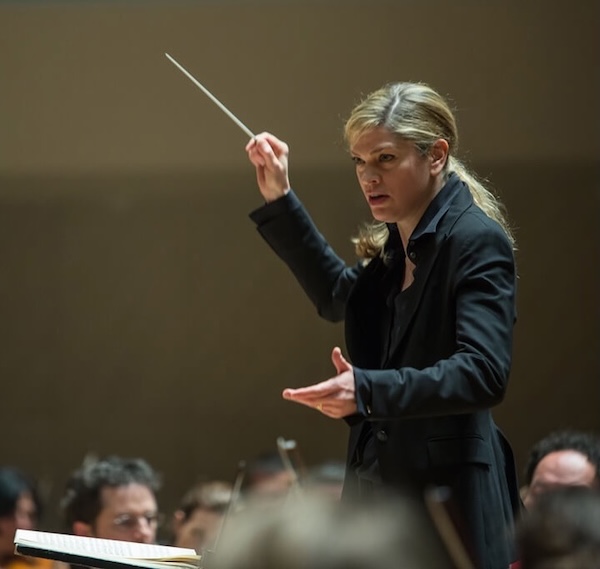Wilson, Philharmonic deliver gripping Shostakovich despite filmic distractions

Breathes there a classical music fan who hasn’t, at some time, thought about something—a story, a picture, a video—to go with his or her favorite piece?
Generally, it’s wiser to enjoy such thoughts in one’s own mind than to subject other people to them. This week, however, audiences at the New York Philharmonic are watching one man’s visualization of the meaning of Shostakovich’s Symphony No. 10 while the work itself is playing.
In the program’s second performance on Friday, conductor Keri-Lynn Wilson, founding music director of the Ukrainian Freedom Orchestra, led a dark, compelling rendition of this key work of the 20th century. A film by William Kentridge, Oh to Believe in Another World, running simultaneously with the symphony, proved to be more of a distraction than an enhancement.
While Shostakovich’s masterpiece didn’t need a film, Kentridge’s film definitely needed Shostakovich’s music to sustain interest in its repetitious imagery for almost an hour.
Composing immediately after the death of Soviet dictator Joseph Stalin in 1953, Shostakovich poured into his symphony all the emotions of an artist living under a tyrannical regime, and by extension the Soviet people themselves.
Accordingly, Kentridge opened his film with vintage footage of Soviet citizens going about their daily lives, after first establishing the period with imagery of scratchy black and white film running through a projector, complete with countdown frames.
The main action of the film, however, was a puppet show, as figures with the heads of Shostakovich, Stalin, and other historical persons danced jerkily inside a miniature set representing an old Russian museum. Every so often Soviet slogans or cryptic phrases (“We’ll make shoes from the sky”) appeared onscreen, like titles in a silent movie.
This concept had Russian musical associations that the filmmaker may or may not have been aware of. The camera roaming from room to room of the dollhouse museum brought thoughts of Mussorgsky’s art stroll in Pictures at an Exhibition. And Shostakovich himself made money in his student days accompanying silent movies on the piano (but was fired for laughing too loudly at Charlie Chaplin).
In any case, the film itself had much to recommend it. The sets by Sabine Theunissen captured the musty atmosphere of a down-at-heels museum, an old movie theater, an abandoned diving pool. The Cubist puppets by Greta Goiris moved disjointedly, as if about to disintegrate. Kentridge’s moving camera and projections-within-projections added visual interest.
But while Shostakovich’s symphony evolved over its nearly-an-hour duration, the film didn’t. It took only a few minutes to get the movie’s message—dictator bad, composer cautious, composer’s friends worried, Lenin and Trotsky lurking in the corners—and then the filmmaker had most of an hour to fill with variations on what the viewer had already seen.
And while that viewer was puzzling over the symbolism of Stalin standing on a diving platform and throwing confetti into an empty swimming pool, 103 bars of the most significant music of the 20th century went by unregistered.
Happy the concertgoer who could close his or her eyes and concentrate on the superb performance by Wilson and the orchestra. One could sense the conductor’s pushing and shaping the long Moderato first movement, driving it gradually to a searing climax over a whirring snare drum. The tension flagged a bit during the soft duet of clarinets over low pizzicato, but shapely strings and a high, vanishing piccolo brought the movement to an affecting close.
In the quasi-scherzo, strings barked out the brutal phrases in duple rhythm (a symbol of Stalin in this composer’s works). Shostakovich’s harsh message was clear, and it wasn’t the rosy Socialist Realism of the farm machines and industrial workers that filmmaker Kentridge matched to this music.
The nocturnal Allegretto found a solo bassoon–where would Russian music be without bassoons?–waltzing gently over another pizzicato accompaniment. In this haven from the storm, the composer himself, represented by his four-note hallmark (DSCH) and summoned by soft horn calls, emerged from hiding as it were, reflecting on secret beauties including his then-withheld Violin Concerto. The tenderness of the woodwinds’ response said it all.
A mournful bassoon led the way in the finale’s opening Andante, followed by other plaintive wind solos, until finally a rush of strings sent the music swirling to its eventual sudden finish, the composer shaking his DSCH fist the whole way. The orchestra’s bracing delivery under Wilson’s baton captured the paradoxical character summed up by the Soviet Composers Union in 1953 as “optimistic tragedy” and later by the British critic Hugh Ottaway as “tense exuberance.”
About the concert’s first half, perhaps the less said the better. The claim to fame of Shostakovich’s Festive Overture is that the composer dashed it off in an afternoon at the urgent request of the Bolshoi Theater, which was celebrating the anniversary of the October Revolution that night. It was a noisy thing, cleverly constructed, and Wilson and the Philharmonic knocked it out of the park, slam-dunked it, or spiked it in the end zone, whatever metaphor you prefer.
The Philharmonic’s concertmaster Frank Huang was featured in Prokofiev’s Violin Concerto No. 2. A favorite with Philharmonic audiences for his expressive solos in pieces like Sheherazade and Brahms’s First Symphony, and blessed with abundant technique on his instrument, Huang nevertheless appeared on this occasion not to know the first thing about commanding the stage as a concerto soloist.
Unable to shed his organization-man demeanor, the violinist plodded through the concerto’s three movements without so much as looking up, leaving Wilson and the orchestra sounding stumped as to how to proceed. An embarrassing moment for the New York Philharmonic.
It appeared virtually all the week’s rehearsal time had gone into the Shostakovich symphony, and for that at least one can be grateful.
The program will be repeated 7:30 p.m. Saturday. nyphil.org